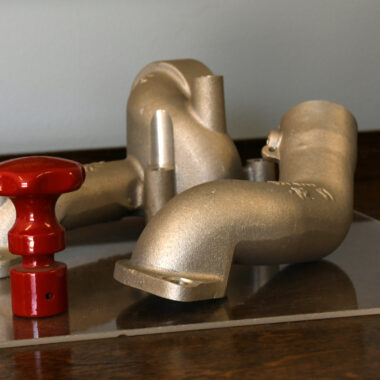About Aluminum Casting Chronicles: Strategies, Fads, and Tips
About Aluminum Casting Chronicles: Strategies, Fads, and Tips
Blog Article
Crafting Perfection: How to Accomplish High-Quality Light Weight Aluminum Castings Whenever
In the world of aluminum spreading, the pursuit of perfection is a continuous trip that requires a meticulous technique and a keen understanding of the intricacies entailed. Achieving constant top quality aluminum spreadings demands a comprehensive grasp of the processes, from selecting the proper alloy to executing precise mold designs and carefully managing spreading criteria.
Comprehending Aluminum Casting Procedures
Aluminum casting procedures, necessary in the manufacturing industry, entail the elaborate transformation of liquified aluminum right into strong forms through a series of meticulously controlled steps. Understanding these procedures is extremely important to attaining premium light weight aluminum spreadings consistently - about aluminum casting. The key methods made use of in light weight aluminum spreading are die casting, sand casting, and investment spreading

Each of these processes has its benefits and is picked based upon aspects like intricacy, quantity, and preferred coating of the aluminum spreading. about aluminum casting. Comprehending the ins and outs of these techniques is crucial for makers intending to produce top notch light weight aluminum spreadings constantly
Picking the Right Aluminum Alloy
Choosing the suitable light weight aluminum alloy is a critical choice in the manufacturing of premium aluminum castings. When picking an aluminum alloy for casting, it is crucial to take into consideration the details needs of the application to guarantee optimal efficiency.
Among one of the most commonly utilized light weight aluminum alloys for casting is A356. This alloy offers exceptional castability, high strength, and great rust resistance, making it appropriate for a variety of applications. 6061 light weight aluminum alloy is favored for its premium weldability and great mechanical residential or commercial properties. For applications calling for high toughness, 7075 aluminum alloy is a preferred choice due to its phenomenal strength-to-weight ratio.
Along with mechanical residential properties, considerations such as expense, schedule, and post-casting procedures must also influence the selection of the ideal aluminum alloy. By thoroughly reviewing these variables, makers can make sure the production of premium aluminum castings that fulfill the wanted specifications.
Applying Appropriate Mold And Mildew Layout
Developing an effective mold layout is important for making certain the successful manufacturing of high-grade light weight aluminum castings. Appropriate mold and mildew style plays a considerable function in accomplishing the desired attributes of the final item. To implement an effective mold and mildew design, factors such navigate to this website as product flow, cooling down prices, and part geometry need to be meticulously thought about.
One secret facet of mold and mildew style is making certain correct filling and solidification of the light weight aluminum within the mold and mildew dental caries. This includes creating jogger and gating systems that facilitate smooth steel flow and prevent flaws such as air entrapment or incomplete filling. In addition, integrating cooling channels right into the mold layout helps control solidification prices and decrease the threat of porosity or shrinkage defects.

Controlling Casting Parameters

Making Sure Post-Casting Quality Checks
To preserve the top quality of light weight aluminum spreadings, thorough post-casting top quality checks are important. After the spreading process is completed, it is essential to guarantee that the end products fulfill the wanted specifications and standards. One of the primary quality checks involves evaluating the surface area browse around here coating of the spreadings to identify any kind of problems such as porosity, fractures, or surface irregularities. This aesthetic assessment is usually supplemented by non-destructive screening approaches like ultrasonic screening or color penetrant inspection to find inner defects that might compromise the stability of the casting.
Dimensional precision is another vital aspect that needs to be confirmed during post-casting top quality checks. Dimensions of crucial measurements and tolerances need to be taken to validate that the castings satisfy the required specifications. Furthermore, mechanical properties such as solidity, tensile strength, and influence resistance may require to be reviewed with product testing to make certain that the spreadings have the needed toughness and sturdiness for their intended application.
Verdict
To conclude, attaining high-quality aluminum castings calls for a detailed understanding of the spreading procedures, choosing the proper alloy, making mold and mildews properly, controlling casting criteria meticulously, and conducting post-casting top quality checks vigilantly. By following these steps, producers can regularly create light weight aluminum spreadings that satisfy the greatest standards of quality and performance.
Attaining consistent high-grade aluminum castings requires a comprehensive understanding of the processes, from choosing the appropriate alloy to performing specific mold designs and diligently controlling casting criteria. The key approaches made use of in light weight aluminum casting are die spreading, sand casting, and investment casting.
Investment casting, likewise understood as accuracy spreading, entails producing wax patterns that are coated in ceramic to develop mold and mildews.Selecting the suitable aluminum alloy is a visit this site vital choice in the manufacturing of top quality light weight aluminum spreadings.Guaranteeing exact control over spreading parameters is necessary for preserving consistency and quality in aluminum casting production.
Report this page